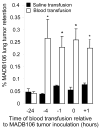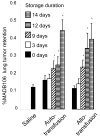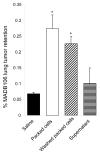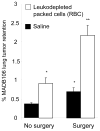Blood transfusion promotes cancer progression: a critical role for aged erythrocytes
- PMID: 19034095
- PMCID: PMC2694914
- DOI: 10.1097/ALN.0b013e31818ddb72
Blood transfusion promotes cancer progression: a critical role for aged erythrocytes
Abstract
Background: In cancer patients, allogeneic blood transfusion is associated with poorer prognosis, but the independent effect of the transfusion is controversial. Moreover, mediating mechanisms underlying the alleged cancer-promoting effects of blood transfusion are unknown, including the involvement of donors' leukocytes, erythrocytes, and soluble factors.
Method: Two syngeneic tumor models were used in Fischer 344 rats, the MADB106 mammary adenocarcinoma and the CRNK-16 leukemia. Outcomes included host ability to clear circulating cancer cells, and host survival rates. The independent impact of blood transfusion was assessed, and potential deleterious characteristics of the transfusion were studied, including blood storage duration; the role of erythrocytes, leukocyte, and soluble factors; and the kinetics of the effects.
Results: Blood transfusion was found to be an independent and significant risk factor for cancer progression in both models, causing up to a fourfold increase in lung tumor retention and doubling mortality rates. Blood storage time was the critical determinant of these deleterious effects, regardless of whether the transfused blood was allogeneic or autogenic. Surprisingly, aged erythrocytes (9 days and older), rather than leukocytes or soluble factors, mediated the effects, which occurred in both operated and nonoperated animals. The effects of erythrocytes transfusion in the MADB106 model emerged immediately and dissipated within 24 h.
Conclusions: In rats, transfusion of fresh blood is less harmful than transfusion of stored blood in the context of progressing malignancies. Further studies should address mediating mechanisms through which erythrocytes' storage duration can impact the rate of complications while treating malignant diseases and potentially other pathologies.
Figures







Comment in
-
Patient blood management: the pragmatic solution for the problems with blood transfusions.Anesthesiology. 2008 Dec;109(6):951-3. doi: 10.1097/ALN.0b013e31818e3d75. Anesthesiology. 2008. PMID: 19034088 No abstract available.
-
Patient blood management and transfusion.Anesthesiology. 2009 Aug;111(2):444-5; author reply 445-6. doi: 10.1097/ALN.0b013e3181ac1e43. Anesthesiology. 2009. PMID: 19625806 No abstract available.
-
The aged erythrocyte: key player in cancer progression, but also in infectious and respiratory complications of blood transfusion?Anesthesiology. 2009 Aug;111(2):444. doi: 10.1097/ALN.0b013e3181ac1e2d. Anesthesiology. 2009. PMID: 19625807 No abstract available.
References
-
- Klein HG. Immunomodulatory aspects of transfusion: a once and future risk? Anesthesiology. 1999;91:861–5. - PubMed
-
- Vamvakas EC. Why have meta-analyses of randomized controlled trials of the association between non-white-blood-cell-reduced allogeneic blood transfusion and postoperative infection produced discordant results? Vox Sang. 2007;93:196–207. - PubMed
-
- Opelz G, Sengar DP, Mickey MR, Terasaki PI. Effect of blood transfusions on subsequent kidney transplants. Transplant Proc. 1973;5:253–9. - PubMed
-
- Opelz G, Vanrenterghem Y, Kirste G, Gray DW, Horsburgh T, Lachance JG, Largiader F, Lange H, Vujaklija-Stipanovic K, Alvarez-Grande J, Schott W, Hoyer J, Schnuelle P, Descoeudres C, Ruder H, Wujciak T, Schwarz V. Prospective evaluation of pretransplant blood transfusions in cadaver kidney recipients. Transplantation. 1997;63:964–7. - PubMed
-
- van Twuyver E, Mooijaart RJ, ten Berge IJ, van der Horst AR, Wilmink JM, Kast WM, Melief CJ, de Waal LP. Pretransplantation blood transfusion revisited. N Engl J Med. 1991;325:1210–3. - PubMed
Publication types
MeSH terms
Grants and funding
LinkOut - more resources
Full Text Sources
Medical

